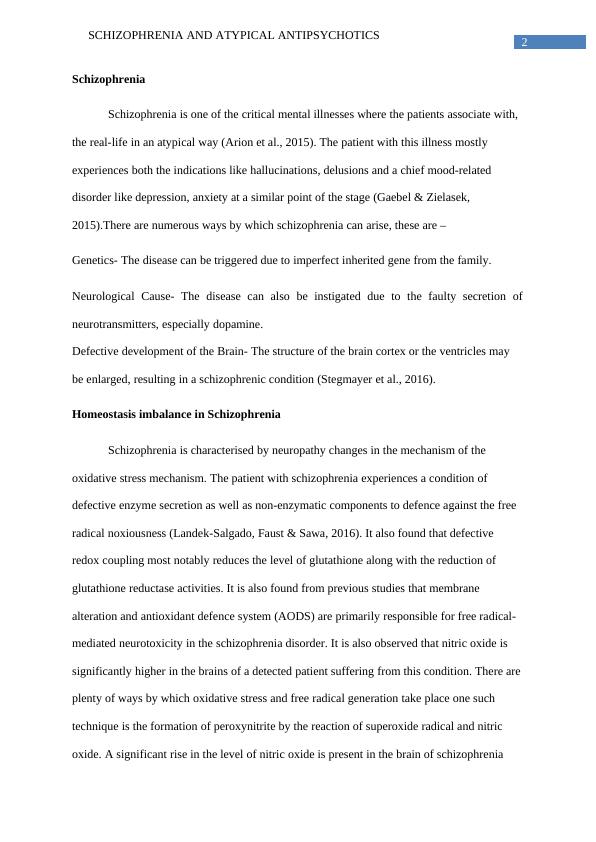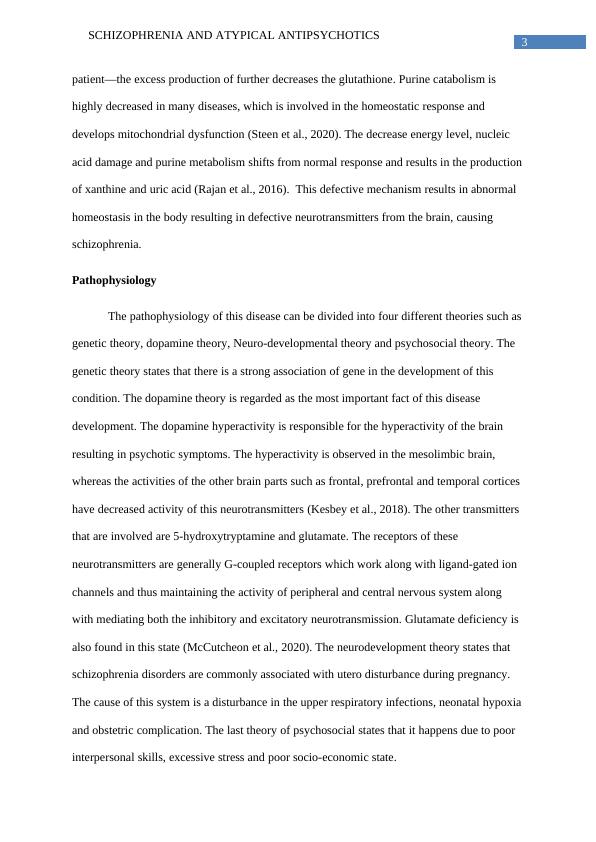Schizophrenia and Atypical Antipsychotics | Report
Added on 2022-09-07
12 Pages2842 Words22 Views
Running Head: SCHIZOPHRENIA AND ATYPICAL ANTIPSYCHOTICS
Schizophrenia and atypical antipsychotics
Name of the Student
Name of the University
Author Note
Schizophrenia and atypical antipsychotics
Name of the Student
Name of the University
Author Note

1
SCHIZOPHRENIA AND ATYPICAL ANTIPSYCHOTICS
Abstract
Schizophrenia is a long-lasting mixed syndrome of muddled and unusual thoughts,
hallucinations, inappropriate effect, and cognitive impairment. The primary purpose of the
below paper is to provide a brief idea about the psychological disorder named schizophrenia
along with its pathophysiology and drugs used in treating the condition. Schizophrenia is
marked by severely impaired emotions, thinking and behaviour. The patient suffering from
this state is unable to filter many sensory stimuli and have enhanced perceptions of colours,
sounds and other environmental features. There are several types of this condition like
catatonic, hebephrenic and paranoid. Catatonic condition is characterised by motor symptoms
that are the patients’ experiences severe immobility issues such as bizarre movements.
Paranoid involves cognitive impairment along with delusion signs. The disease disrupts the
homeostasis condition of the body, such as raising the nitric oxide level in the patient body.
The condition alters the purine metabolism, which in turn affects the mitochondrial
dysfunction. The main pathophysiology comprises of few theories such as genetic theory,
which states that the disease happens due to a strong genetic association. The dopamine
theory highlights the hyper and hypoactivity of the dopamine resulting in positive and
negative symptoms. Other theories are neuro-development and psychosocial. Magnetic
resonance imaging and X-ray can diagnose the condition. Antipsychotic drugs such as
chlorpromazine, haloperidol, thioridazine, trifluoperazine control this state by a different
mechanism. The drug has two generations first and second. The paper also focuses on a few
non-pharmacological interventions to reduce this condition. Lastly, the paper discusses the
nursing management of this condition.
SCHIZOPHRENIA AND ATYPICAL ANTIPSYCHOTICS
Abstract
Schizophrenia is a long-lasting mixed syndrome of muddled and unusual thoughts,
hallucinations, inappropriate effect, and cognitive impairment. The primary purpose of the
below paper is to provide a brief idea about the psychological disorder named schizophrenia
along with its pathophysiology and drugs used in treating the condition. Schizophrenia is
marked by severely impaired emotions, thinking and behaviour. The patient suffering from
this state is unable to filter many sensory stimuli and have enhanced perceptions of colours,
sounds and other environmental features. There are several types of this condition like
catatonic, hebephrenic and paranoid. Catatonic condition is characterised by motor symptoms
that are the patients’ experiences severe immobility issues such as bizarre movements.
Paranoid involves cognitive impairment along with delusion signs. The disease disrupts the
homeostasis condition of the body, such as raising the nitric oxide level in the patient body.
The condition alters the purine metabolism, which in turn affects the mitochondrial
dysfunction. The main pathophysiology comprises of few theories such as genetic theory,
which states that the disease happens due to a strong genetic association. The dopamine
theory highlights the hyper and hypoactivity of the dopamine resulting in positive and
negative symptoms. Other theories are neuro-development and psychosocial. Magnetic
resonance imaging and X-ray can diagnose the condition. Antipsychotic drugs such as
chlorpromazine, haloperidol, thioridazine, trifluoperazine control this state by a different
mechanism. The drug has two generations first and second. The paper also focuses on a few
non-pharmacological interventions to reduce this condition. Lastly, the paper discusses the
nursing management of this condition.

2
SCHIZOPHRENIA AND ATYPICAL ANTIPSYCHOTICS
Schizophrenia
Schizophrenia is one of the critical mental illnesses where the patients associate with,
the real-life in an atypical way (Arion et al., 2015). The patient with this illness mostly
experiences both the indications like hallucinations, delusions and a chief mood-related
disorder like depression, anxiety at a similar point of the stage (Gaebel & Zielasek,
2015).There are numerous ways by which schizophrenia can arise, these are –
Genetics- The disease can be triggered due to imperfect inherited gene from the family.
Neurological Cause- The disease can also be instigated due to the faulty secretion of
neurotransmitters, especially dopamine.
Defective development of the Brain- The structure of the brain cortex or the ventricles may
be enlarged, resulting in a schizophrenic condition (Stegmayer et al., 2016).
Homeostasis imbalance in Schizophrenia
Schizophrenia is characterised by neuropathy changes in the mechanism of the
oxidative stress mechanism. The patient with schizophrenia experiences a condition of
defective enzyme secretion as well as non-enzymatic components to defence against the free
radical noxiousness (Landek-Salgado, Faust & Sawa, 2016). It also found that defective
redox coupling most notably reduces the level of glutathione along with the reduction of
glutathione reductase activities. It is also found from previous studies that membrane
alteration and antioxidant defence system (AODS) are primarily responsible for free radical-
mediated neurotoxicity in the schizophrenia disorder. It is also observed that nitric oxide is
significantly higher in the brains of a detected patient suffering from this condition. There are
plenty of ways by which oxidative stress and free radical generation take place one such
technique is the formation of peroxynitrite by the reaction of superoxide radical and nitric
oxide. A significant rise in the level of nitric oxide is present in the brain of schizophrenia
SCHIZOPHRENIA AND ATYPICAL ANTIPSYCHOTICS
Schizophrenia
Schizophrenia is one of the critical mental illnesses where the patients associate with,
the real-life in an atypical way (Arion et al., 2015). The patient with this illness mostly
experiences both the indications like hallucinations, delusions and a chief mood-related
disorder like depression, anxiety at a similar point of the stage (Gaebel & Zielasek,
2015).There are numerous ways by which schizophrenia can arise, these are –
Genetics- The disease can be triggered due to imperfect inherited gene from the family.
Neurological Cause- The disease can also be instigated due to the faulty secretion of
neurotransmitters, especially dopamine.
Defective development of the Brain- The structure of the brain cortex or the ventricles may
be enlarged, resulting in a schizophrenic condition (Stegmayer et al., 2016).
Homeostasis imbalance in Schizophrenia
Schizophrenia is characterised by neuropathy changes in the mechanism of the
oxidative stress mechanism. The patient with schizophrenia experiences a condition of
defective enzyme secretion as well as non-enzymatic components to defence against the free
radical noxiousness (Landek-Salgado, Faust & Sawa, 2016). It also found that defective
redox coupling most notably reduces the level of glutathione along with the reduction of
glutathione reductase activities. It is also found from previous studies that membrane
alteration and antioxidant defence system (AODS) are primarily responsible for free radical-
mediated neurotoxicity in the schizophrenia disorder. It is also observed that nitric oxide is
significantly higher in the brains of a detected patient suffering from this condition. There are
plenty of ways by which oxidative stress and free radical generation take place one such
technique is the formation of peroxynitrite by the reaction of superoxide radical and nitric
oxide. A significant rise in the level of nitric oxide is present in the brain of schizophrenia

3
SCHIZOPHRENIA AND ATYPICAL ANTIPSYCHOTICS
patient—the excess production of further decreases the glutathione. Purine catabolism is
highly decreased in many diseases, which is involved in the homeostatic response and
develops mitochondrial dysfunction (Steen et al., 2020). The decrease energy level, nucleic
acid damage and purine metabolism shifts from normal response and results in the production
of xanthine and uric acid (Rajan et al., 2016). This defective mechanism results in abnormal
homeostasis in the body resulting in defective neurotransmitters from the brain, causing
schizophrenia.
Pathophysiology
The pathophysiology of this disease can be divided into four different theories such as
genetic theory, dopamine theory, Neuro-developmental theory and psychosocial theory. The
genetic theory states that there is a strong association of gene in the development of this
condition. The dopamine theory is regarded as the most important fact of this disease
development. The dopamine hyperactivity is responsible for the hyperactivity of the brain
resulting in psychotic symptoms. The hyperactivity is observed in the mesolimbic brain,
whereas the activities of the other brain parts such as frontal, prefrontal and temporal cortices
have decreased activity of this neurotransmitters (Kesbey et al., 2018). The other transmitters
that are involved are 5-hydroxytryptamine and glutamate. The receptors of these
neurotransmitters are generally G-coupled receptors which work along with ligand-gated ion
channels and thus maintaining the activity of peripheral and central nervous system along
with mediating both the inhibitory and excitatory neurotransmission. Glutamate deficiency is
also found in this state (McCutcheon et al., 2020). The neurodevelopment theory states that
schizophrenia disorders are commonly associated with utero disturbance during pregnancy.
The cause of this system is a disturbance in the upper respiratory infections, neonatal hypoxia
and obstetric complication. The last theory of psychosocial states that it happens due to poor
interpersonal skills, excessive stress and poor socio-economic state.
SCHIZOPHRENIA AND ATYPICAL ANTIPSYCHOTICS
patient—the excess production of further decreases the glutathione. Purine catabolism is
highly decreased in many diseases, which is involved in the homeostatic response and
develops mitochondrial dysfunction (Steen et al., 2020). The decrease energy level, nucleic
acid damage and purine metabolism shifts from normal response and results in the production
of xanthine and uric acid (Rajan et al., 2016). This defective mechanism results in abnormal
homeostasis in the body resulting in defective neurotransmitters from the brain, causing
schizophrenia.
Pathophysiology
The pathophysiology of this disease can be divided into four different theories such as
genetic theory, dopamine theory, Neuro-developmental theory and psychosocial theory. The
genetic theory states that there is a strong association of gene in the development of this
condition. The dopamine theory is regarded as the most important fact of this disease
development. The dopamine hyperactivity is responsible for the hyperactivity of the brain
resulting in psychotic symptoms. The hyperactivity is observed in the mesolimbic brain,
whereas the activities of the other brain parts such as frontal, prefrontal and temporal cortices
have decreased activity of this neurotransmitters (Kesbey et al., 2018). The other transmitters
that are involved are 5-hydroxytryptamine and glutamate. The receptors of these
neurotransmitters are generally G-coupled receptors which work along with ligand-gated ion
channels and thus maintaining the activity of peripheral and central nervous system along
with mediating both the inhibitory and excitatory neurotransmission. Glutamate deficiency is
also found in this state (McCutcheon et al., 2020). The neurodevelopment theory states that
schizophrenia disorders are commonly associated with utero disturbance during pregnancy.
The cause of this system is a disturbance in the upper respiratory infections, neonatal hypoxia
and obstetric complication. The last theory of psychosocial states that it happens due to poor
interpersonal skills, excessive stress and poor socio-economic state.

End of preview
Want to access all the pages? Upload your documents or become a member.
Related Documents
Schizophrenia and Asymptomatic Antipsychotics Assignment 2022lg...
|10
|2376
|12
Schizoaffective Disorder Schizophrenialg...
|13
|4531
|28
Imaging Approaches to the Study of Schizophrenialg...
|11
|2628
|140
Schizophrenia: Causes, Symptoms, and Recoverylg...
|5
|1095
|60
Mental Health and Schizophrenia in Criminal Justicelg...
|7
|1490
|358
Comparing the effectiveness of non-pharmacological and pharmacological interventions for Schizophrenia in UK: systematic reviewlg...
|5
|981
|217